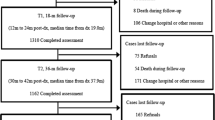Abstract
Among patients with breast cancer, few studies have examined the pattern of change of physical activity levels over time or the predictive factors for this change. Particularly sparse are studies comparing pre-surgical physical activity levels with those 12 months post-surgery. Patients with a primary operable breast cancer (N = 267) filled in the Physical Activity Computerised Questionnaire before breast surgery and 1, 3, 6 and 12 months post-operatively. Patient-, disease- and treatment-related factors were prospectively collected. Total physical activity level and occupational, sport and household activity levels were significantly decreased the first month post-operatively and did not recover during the first year after surgery. ‘Being employed’ was a predictive factor for a larger decrease of the total activity level, comparing the pre-operative and 12 months post-surgery stages. Having a spouse, a pN2-3 lesion and over 20 lymph nodes dissected predicted a decrease in occupational activity. Advanced age and smoking behaviour predicted a decrease in sport activities, and not having a spouse predicted a decrease in household activities. This study showed that 1 year after breast cancer surgery, pre-operative physical activity levels were not recovered. Breast cancer patients, and in particular those at risk for a decreased physical activity level, should be identified, encouraged and guided to increase their activities.


Similar content being viewed by others
References
Glass AG, Lacey JV, Carreon JD, Hoover RN (2007) Breast cancer incidence, 1980–2006: combined roles of menopausal hormone therapy, screening mammography, and estrogen receptor status. J Natl Cancer Inst 99:1152–1161. doi:10.1093/jnci/djm059
Alfano CM, Smith AW, Irwin ML et al (2007) Physical activity, long-term symptoms, and physical health-related quality of life among breast cancer survivors: a prospective analysis. J Cancer Surviv 1:116–128. doi:10.1007/s11764-007-0014-1
Patterson RE, Cadmus LA, Emond JA, Pierce JP (2010) Physical activity, diet, adiposity and female breast cancer prognosis: a review of the epidemiologic literature. Maturitas. doi:10.1016/j.maturitas.2010.01.004
Pinto BM, Trunzo JJ, Reiss P, Shiu SY (2002) Exercise participation after diagnosis of breast cancer: trends and effects on mood and quality of life. Psycho-oncology 11:389–400. doi:10.1002/pon.594
Harisson S, Hayes SC, Newman B (2009) Level of physical activity and characteristics associated with change following breast cancer diagnosis and treatment. Psycho-oncology 18:387–394. doi:10.1002/pon.1504
Andrykowski MA, Beacham AO, Jacobsen PB (2007) Prospective, longitudinal study of leisure-time exercise in women with early-stage breast cancer. Cancer Epidemiol Biomarkers Prev 16:430–438. doi:10.1158/1055-9965.EPI-06-0735
Irwin ML, Crumley D, McTiernan A et al (2003) Physical activity levels before and after a diagnosis of breast carcinoma: the Health, Eating, Activity, and Lifestyle (HEAL) study. Cancer 97:1746–1757. doi:10.1002/cncr.11227
Littman AJ, Tang MT, Rossing MA (2010) Longitudinal study of recreational physical activity in breast cancer survivors. J Cancer Surviv. doi:10.1007/s11764-009-0113-2
Matton L, Wijndaele K, Duvigneaud N et al (2007) Reliability and validity of the Flemish physical activity computerized questionnaire in adults. Res Q Exerc Sport 78:293–306
Ainsworth BE, Haskell WL, Whitt MC et al (2000) Compendium of physical activities: an update of activity codes and MET intensities. Med Sci Sports Exerc 32:S498–S504
Devoogdt N, Lemkens H, Geraerts I et al (2010) A new device to measure upper limb circumferences: validity and reliability. Int Angiol (submitted)
Rietman JS, Dijkstra PU, Debreczeni R, Geertzen JHB, Robinson DPH, De Vries J (2004) Impairments, disabilities and health related quality of life after treatment for breast cancer: a follow-up study 2.7 years after surgery. Disab Rehabil 26:78–84. doi:10.1080/09638280310001629642
Verbeke G, Molenberghs G (1997) Linear mixed models in practice: a SAS-oriented approach. Lecture Notes in Statistics, vol 126. Springer, New York
Satariano WA, DeLorenze GN (1996) The likelihood of returning to work after breast cancer. Public Health Rep 111:236–241
Drolet M, Maunsell E, Mondor M et al (2005) Work absence after breast cancer diagnosis: a population-based study. CMAJ 173:765–771. doi:10.1503/cmaj.050178
Roelen CAM, Koopmans PC, de Graaf JH, Balak F, Groothoff JW (2009) Sickness absence and return to work rates in women with breast cancer. Int Arch Occup Environ Health 82:543–546. doi:10.1007/s00420-008-0359-4
Johnsson A, Fornander T, Rutqvist L et al (2009) Predictors of return to work ten months after primary breast cancer surgery. Acta Oncol 48:93–98. doi:10.1080/02841860802477899
Fantoni SQ, Peugniez C, Duhamel A, Skrzypczak J, Frimat P, Leroyer A (2009) Factors related to return to work by women with breast cancer in Northern France. J Occup Rehabil. doi:10.1007/s10926-009-9215-y
Hong S, Bardwell WA, Natarajan L et al (2007) Correlates of physical activity level in breast cancer survivors participating in the Women’s Healthy Eating and Living (WHEL) study. Breast Cancer Res Treat 101:225–232. doi:10.1007/s10549-006-9284-y
Acknowledgements
This study was supported by a grant from the agency for Innovation by Science and Technology (Applied Biomedical Research). We wish to thank all the patients participating in this study, to fill in the questionnaire at five different time points and to come to the hospital for the measurements of their arm. Furthermore, we would like to thank Shirli Roimi, Tinne Van Dyck and Julie Reyniers for helping with the collection of data.
Author information
Authors and Affiliations
Corresponding author
Rights and permissions
About this article
Cite this article
Devoogdt, N., Van Kampen, M., Geraerts, I. et al. Physical activity levels after treatment for breast cancer: one-year follow-up. Breast Cancer Res Treat 123, 417–425 (2010). https://doi.org/10.1007/s10549-010-0997-6
Received:
Accepted:
Published:
Issue Date:
DOI: https://doi.org/10.1007/s10549-010-0997-6




